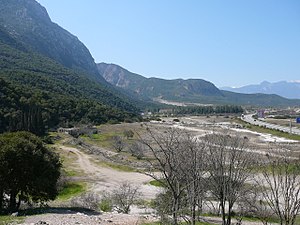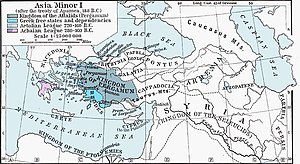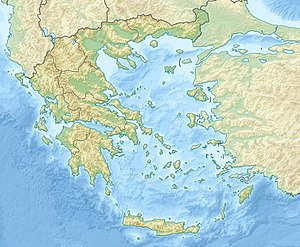Battle of Thermopylae (191 BC)
| Battle of Thermopylae | |||||||
|---|---|---|---|---|---|---|---|
| Part of the Roman–Seleucid War | |||||||
 View of the Thermopylae pass from the area of the Phocian Wall. | |||||||
| |||||||
| Belligerents | |||||||
| Roman Republic |
Seleucid Empire Aetolian League | ||||||
| Commanders and leaders | |||||||
|
Manius Acilius Glabrio Marcus Porcius Cato Lucius Valerius Flaccus | Antiochus III the Great | ||||||
| Strength | |||||||
| 25,000 to 30,000 |
12,500 16 war elephants | ||||||
| Casualties and losses | |||||||
|
12,000 16 war elephants | |||||||
Location of the Battle of Thermopylae (191 BC) | |||||||
The Battle of Thermopylae took place on 24 April 191 BC. It was fought as part of the
When the main bodies of the armies initially clashed at the Thermopylae pass, the Seleucids managed to hold their ground, repulsing multiple Roman assaults. However, a small Roman force under Marcus Porcius Cato managed to outflank the Seleucids from the hillside after surprising the Aetolian garrison of Fort Callidromus. The Seleucids panicked and broke ranks, leading to the destruction of their force. Antiochus managed to escape the battlefield with his cavalry, departing mainland Greece soon afterwards.
Background
Following his return from his Bactrian (210–209 BC)
In late winter 196/195 BC, Rome's erstwhile chief enemy, Carthaginian general Hannibal, fled from Carthage to Antiochus' court in Ephesus. Despite the emergence of a pro-war party led by Scipio Africanus, the Roman Senate exercised restraint. Negotiations between the Romans and the Seleucids resumed, coming to a standstill once again, over differences between Greek and Roman law on the status of disputed territorial possessions. In the summer of 193 BC, a representative of the Aetolian League assured Antiochus that the Aetolians would take his side in a future war with Rome, while Antiochus gave tacit support to Hannibal's plans of launching an anti-Roman coup d'état in Carthage.[6] The Aetolians began spurring Greek states to jointly revolt under Antiochus' leadership against the Romans, hoping to provoke a war between the two parties. The Aetolians then captured the strategically important port city of Demetrias, killing the key members of the local pro-Roman faction. In September 192 BC, Aetolian general Thoantas arrived at Antiochus' court, convincing him to openly oppose the Romans in Greece. The Seleucids selected 10,000 infantry, 500 cavalry, 6 war elephants and 300 ships to be transferred for their campaign in Greece.[7]
Prelude
The Seleucid fleet sailed via
In December 192, the Seleucids and their Aetolian allies launched a campaign against the

Antiochus marched to Lamia with his entire force of 12,000 infantry, 500 cavalry and 16 war elephants, simultaneously ordering the Aetolians to mobilize there.
Battle
Antiochus positioned his
Despite the natural strengths of the position controlled by his adversaries, Glabrio decided to launch an assault; since he held a significant numerical advantage, commanding an army of 25,000 to 30,000 soldiers. He dispatched 2,000 soldiers to besiege Heraclea and left the 2,000 strong cavalry to guard the camp. On the night of 23 April 191 BC, Glabrio ordered Marcus Porcius Cato's and Lucius Valerius Flaccus's 2,000-man detachments to assault the Aetolian controlled forts. At dawn on 24 April, Glabrio led the main Roman force of 18,000 through the pass in a frontal attack.[20][25]
The first Roman assault was repulsed, as the Romans found themselves enfiladed by the Seleucid missile troops.[20] The Romans pressed on, their repeated attacks forcing the argyraspides and the light infantry to withdraw behind the rampart. Yet the wall of Seleucid sarissas proved to be impenetrable for the Romans, halting their advance.[26] Flaccus likewise failed to make headway against the defenders of Teichius and Rhoduntia. Cato on the other hand discovered Callidromus at dawn, having previously lost his way during the night march. The 600-man Aetolian garrison was taken by surprise, fleeing to the Seleucid camp.[27][28] Cato outflanked the Seleucids striking their camp; thinking Cato's force to be much larger than it was in reality, the Seleucids' morale plunged.[26] The Seleucids broke ranks and engaged in a disorganized retreat, the whole army being lost, save for Antiochus and his cavalrymen.[29]
Aftermath

Antiochus was decisively defeated on land and had lost contact with his navy. Upon learning that Glabrio advanced through Phocis and Boeotia without facing any resistance, he rushed back to Ephesus. When the Seleucid garrison at Chalcis followed their emperor back to Asia Minor in May 191 BC, Euboean cities immediately welcomed the Romans as liberators.[29]
The Seleucids then attempted to destroy the Roman fleet before it could unite with those of Rhodes and the Attalids. In September 191 BC, the Roman fleet defeated the Seleucids in the Battle of Corycus, enabling it to take control of several cities including Dardanus and Sestos on the Hellespont.[30] In May 190 BC, Antiochus invaded the Kingdom of Pergamon, ravaging the countryside, besieging its capital and forcing its king, Eumenes II, to return from Greece. In August 190 BC, the Rhodians defeated Hannibal's fleet at the Battle of the Eurymedon. A month later a combined Roman–Rhodian fleet defeated the Seleucids at the Battle of Myonessus. The Seleucids could no longer control the Aegean Sea, opening the way for a Roman invasion of Asia Minor.[31]
Citations
- ^ Lerner 1999, pp. 45–48.
- ^ Overtoom 2020, p. 147.
- ^ Sartre 2006, pp. 89–90.
- ^ Sartre 2006, pp. 91–92.
- ^ Sarikakis 1974, pp. 57–58.
- ^ Sarikakis 1974, pp. 60–62.
- ^ Sarikakis 1974, pp. 63–64.
- ^ Sarikakis 1974, p. 64.
- ^ Waterfield 2014, p. 117.
- ^ Sarikakis 1974, p. 66.
- ^ Waterfield 2014, pp. 117–118.
- ^ Sarikakis 1974, pp. 66–67.
- ^ Waterfield 2014, pp. 118–119.
- ^ Graigner 2002, pp. 217–218.
- ^ Graigner 2002, pp. 224–229.
- ^ Graigner 2002, pp. 230, 234–236.
- ^ Bar-Kochva 1976, p. 158.
- ^ Graigner 2002, p. 238.
- ^ Graigner 2002, pp. 240–242.
- ^ a b c d Sarikakis 1974, p. 68.
- ^ Graigner 2002, pp. 243–244.
- ^ Bar-Kochva 1976, pp. 160–161.
- ^ Bar-Kochva 1976, p. 161.
- ^ Bar-Kochva 1976, pp. 158, 160.
- ^ Graigner 2002, p. 245.
- ^ a b Bar-Kochva 1976, p. 162.
- ^ Sarikakis 1974, pp. 68–69.
- ^ Graigner 2002, p. 246.
- ^ a b Sarikakis 1974, p. 69.
- ^ Sarikakis 1974, pp. 73–74.
- ^ Sarikakis 1974, pp. 74, 76–78.
Sources
- ISBN 9780521206679.
- Graigner, John (2002). The Roman War of Antiochus the Great. Boston: Brill. ISBN 9789004128408.
- Lerner, Jeffrey (1999). The Impact of Seleucid Decline on the Eastern Iranian Plateau: The Foundations of Arsacid Parthia and Graeco-Bactria. Stuttgart: Franz Steiner Verlag. ISBN 9783515074179.
- Overtoom, Nikolaus Leo (2020). Reign of Arrows: The Rise of the Parthian Empire in the Hellenistic Middle East. Oxford: Oxford University Press. ISBN 9780190888329.
- Sarikakis, Theodoros (1974). "Το Βασίλειο των Σελευκιδών και η Ρώμη" [The Seleucid Kingdom and Rome]. In Christopoulos, Georgios A. & Bastias, Ioannis K. (eds.). Ιστορία του Ελληνικού Έθνους, Τόμος Ε΄: Ελληνιστικοί Χρόνοι [History of the Greek Nation, Volume V: Hellenistic Period] (in Greek). Athens: Ekdotiki Athinon. pp. 55–91. ISBN 978-960-213-101-5.
- Sartre, Maurice (2006). Ελληνιστική Μικρασία: Aπο το Αιγαίο ως τον Καύκασο [Hellenistic Asia Minor: From the Aegean to the Caucaus] (in Greek). Athens: Ekdoseis Pataki. ISBN 9789601617565.
- Waterfield, Robin (2014). Taken at the Flood: The Roman Conquest of Greece. Oxford: Oxford University Press. ISBN 9780199916894.

